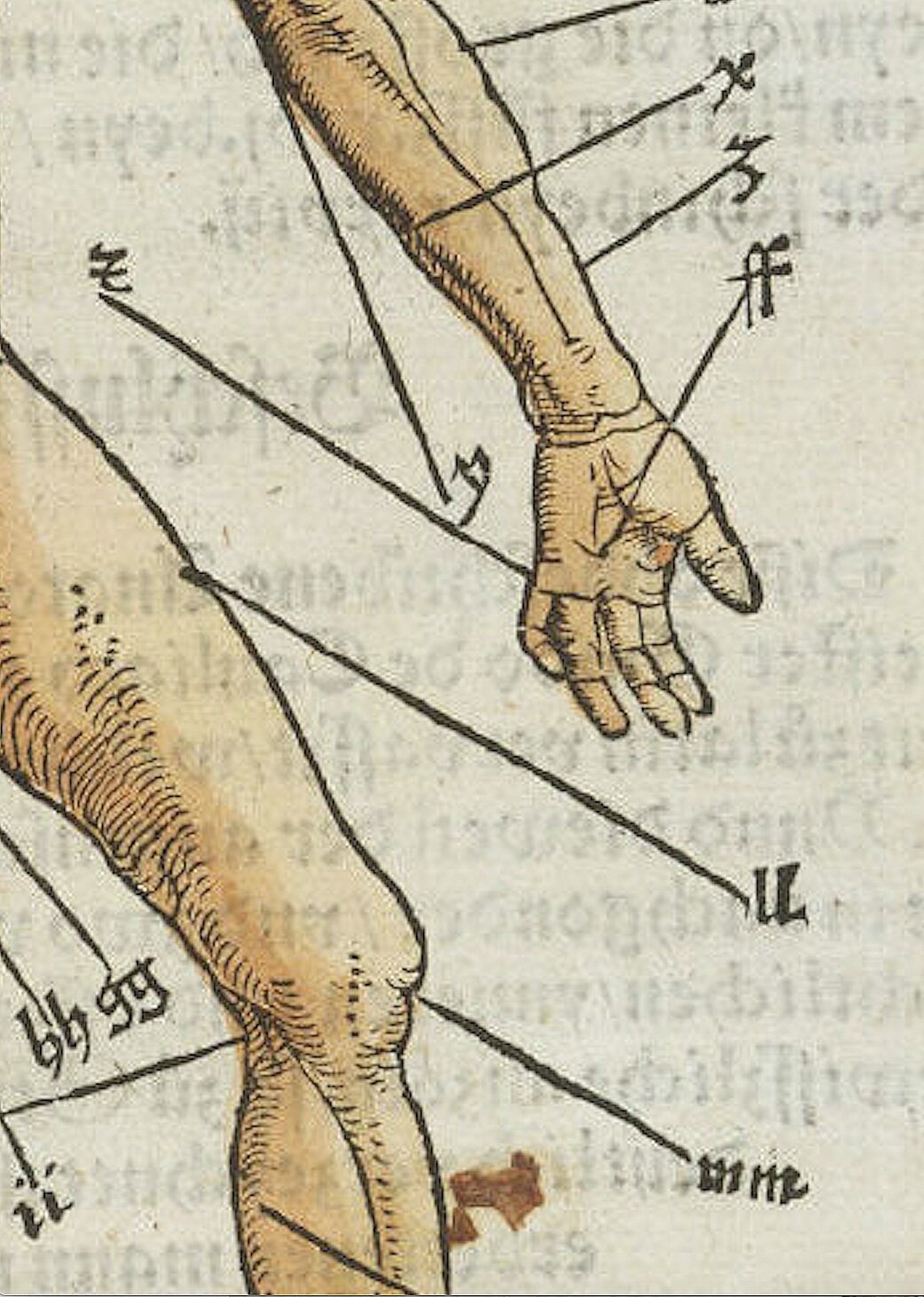Rx 3 / Body Disarticulated
Turning a person into a thing - a cadaver on a dissecting table, a specimen in a jar, an illustration in a textbook - demands labour.
- Richard Barnett, The Sick Rose
Nestled within Feldtbuch der Wundartzney (Field-Book of the Wound Doctor), a portable manual for military surgeons by Hans Gersdorff, Viscera and Bloodletting Man is one of twelve chiaroscuro woodcuts by German Renaissance artist Johannes Wechtlin. The diagram guides doctors through the process of bloodletting, an antiquated practice founded on the belief that illness and maladies resulted from a disequilibrium of the four humours: blood, phlegm, yellow bile and black bile. A patient’s health could be restored, the day’s medics believed, once he or she achieved balance among the four.
Though functionally instructional, Viscera also evokes a pious Renaissance aesthetic and recalls vanitas, a genre of still-life that featured symbols of death—skulls, rotting fruit, dying plants—as a reminder of the transience of life and inescapability of death. That is, the diagram is both an informational document and a work of art, in turn mediating between its subject as specimen and as person.
The identity of the depicted individual was indeed fraught: Viscera depicts the body of a hanged criminal in Strasbourg. During the Renaissance and Enlightenment, executed criminals were highly sought after corporal commodities. The poor and marginalized, the unclaimed dead in public hospitals, jails, and workhouses, and those who could not pay for burial insurance were uniformly targeted for dissection and medical education. In this way, depersonalization and exploitation formed the historical backdrop for the study of gross anatomy.
“a reminder of the transience of life and inescapability of death”
In fact, the authoritative anatomy text, Gray’s Anatomy, initially published in the late 1850s and still widely circulated in medical schools today, employed this practice. The sources and identities of the eight bodies of men, women, and children prominently displayed in their atlas were never identified and likely obtained via bodysnatching. Practiced well into the late-nineteenth century by European and American medical schools, particularly in Philadelphia, bodysnatching was the lucrative enterprise of procuring so-called ‘raw material’ from prisons and African-American cemeteries. Here, we see the socio-racial inequities foundational to modern American medicine: the academic and material advancement of mostly wealthy white men predicated on stolen corpses of the incarcerated, the indigent, and ethnic minorities.
Today’s cadaver customs embody a significant—and increasingly humanist—cultural shift over the past century. What was once a horrifying post-mortem violation of the body is now deemed a venerable contribution to society and education. For many first-year medical students, cadaver dissection is a formative, affecting experience. Some institutions go as far as to invite the deceased’s family to meet the students and share a meal at the onset of anatomy lab. The semester may culminate with a cremation ceremony to honor the donations of the deceased. The first step in cultivating a lifelong practice of empathy in the clinical encounter, students often reflect on their cadaver experiences and are humbled to realize the donor was their first patient.
Courtesy of UNC Health.
Reflections…
One art historian has posited that the evolving depiction of the anatomical body in the Renaissance and Enlightenment represents a movement from artistic style toward an emergent “scientific non-style […] designed to guarantee objectivity and clarity.” (Graciano, 2019.) In other words, Wechtlin’s Viscera reminds us that the contemporary dissection atlas remains historically rooted in a hybrid of art and anatomy. Viscera also crystallizes two fundamental shifts in anatomical diagrams and cadaver dissection: from beautiful artistic rendering to objective disarticulation, and humanistic empathy to dehumanized anonymity.
Does the process of viewing anatomical illustrations require deliberate contextual looking across time and culture? As care providers progress beyond the anatomy lab in their education and training, how can they remain mindful of the complex origins of dissection atlases and its contributions to medical education?
Experience with a dead body was argued to be central to the formation of an ideal physician’s character: detached, thoughtful, aware, analytical. These traits were traditionally espoused as ‘a good doctor.’ Some universities now offer virtual gross anatomy curriculums for graduate, nursing, dental, post-baccalaureate students (though this is generally considered a supplement for medical student gross anatomy lab, and not a replacement.) What fundamental elements of clinical education, tactile memory, and professional development might be forfeited with an online anatomy platform?
Sources
Allen, John Tyler. “Learning Empathy From the Dead.” The Atlantic, Atlantic Media Company, 28 July 2015, www.theatlantic.com/health/archive/2015/07/cadaver-dissection-empathy-medical-school/398429/.
Barnett, R. The Sick Rose: Disease and the Art of Medical Illustration. London, Thames & London, 2014.
“Compassion Begins with the Cadavers.” AAMC, 2018, www.aamc.org/news-insights/compassion-begins-cadavers.
Graciano, A. (Ed.). (2019). Visualizing the Body in Art, Anatomy, and Medicine Since 1800. New York: Routledge, https://doi.org/10.4324/9781351004022
Williams, Austin D., et al. “Medical Students Reactions to Anatomic Dissection and the Phenomenon of Cadaver Naming.” Anatomical Sciences Education, vol. 7, no. 3, Jan. 2013, pp. 169–180., doi:10.1002/ase.1391.







